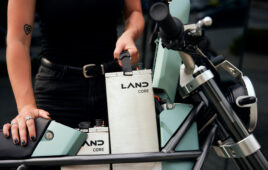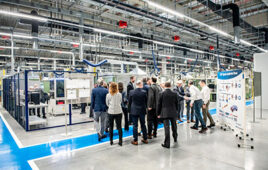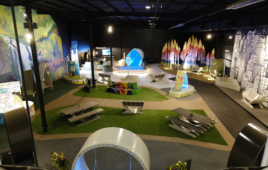The shipping container stores the computer system, priming pump, hydraulic reservoir, hydraulic drive motor, electrical generator, and on one model, a natural-gas compressor.
The U.S. wind energy market includes roughly 30,000+ aging turbines. Of those, around 7,000 are down for repair at any given time. The bulk of repairs are gear failures in gearboxes and yaw drives. Other turbine-stoppers include main-shaft bearings and seal failures, electrical generator overloads, and over-speed brake failures. High costs and duration of repairs negatively impact wind farm ROI, not to mention, the safety risks posed by tower heights over 200 ft.
As a possible solution, Windera Power Systems has designed, built, and deployed what may be the world’s first open and closed loop hydraulic wind turbine. The system replaces the conventional electromechanical drive train with a hydraulic system that converts blade rotation into hydraulic pressure, which is then converted into electrical energy. The system directly addresses gear failures to increase reliability, efficiency, safety, and ROI. What’s more, the company says the direct drive; variable-speed hydraulics can increase the expected life of a turbine. “This technology is less costly and more efficient than conventional wind turbines. Our hydraulic system has the potential to revolutionize the offshore wind market,” says Richard Burt, CTO and Founder, Windera Power Systems, Inc.
The first open loop wind turbine differs from conventional turbines by converting mechanical blade rotation into hydraulic pressure, which is eventually converted into electrical energy.
Their idea replaces the gearbox with hydraulic drive components that have proven reliable under demanding conditions, says the company. The Windera Power design uses the rotor to drive a hydraulic pump in the nacelle which provides high-pressure fluid to a hydraulic motor at ground level. With this Down Tower Power Unit (DTPU), 90% of most mechanical components are on the ground thereby decreasing the need for a crane for many maintenance tasks. According to Windera, built-in intelligence shuts the turbine down when it encounters unsafe operating parameters. A manual shut down is accomplished by the push of one button.
Mechanical braking systems can be downsized because the hydraulics provide that feature. Automatic blade-speed regulation keeps operations within a safe range.
Battery backup eliminates power fluctuations to provide immediate and sustained power output over short periods of wind variation. The company says the system can boost or attenuate power output of individual turbines or wind parks to the specific requirements of the power utility.
The Windera Hydraulic Drive System uses no gearbox thereby eliminating gearbox-related failures.
Currently, the company is manufact-uring three systems. The Windera 300-3 is a 300 kW hydraulic drive system that uses three 100 kW wind turbines connected to one DTPU. Its focus is on repowering 65 to 100 kW turbines. The Windera 750 is a single 750-kW turbine connected to one DTPU and is aimed at repowering legacy 660 to 750-kW turbines. Lastly, the Windera Plus produces power for applications such as natural-gas compressors, water pumps, reverse-osmosis drives, electrical generators, and conveyor drives.
Windpower Engineering & Development
Filed Under: Bearings, Hydraulic equipment + components, Green engineering • renewable energy • sustainability, Gears • gearheads • speed reducers




